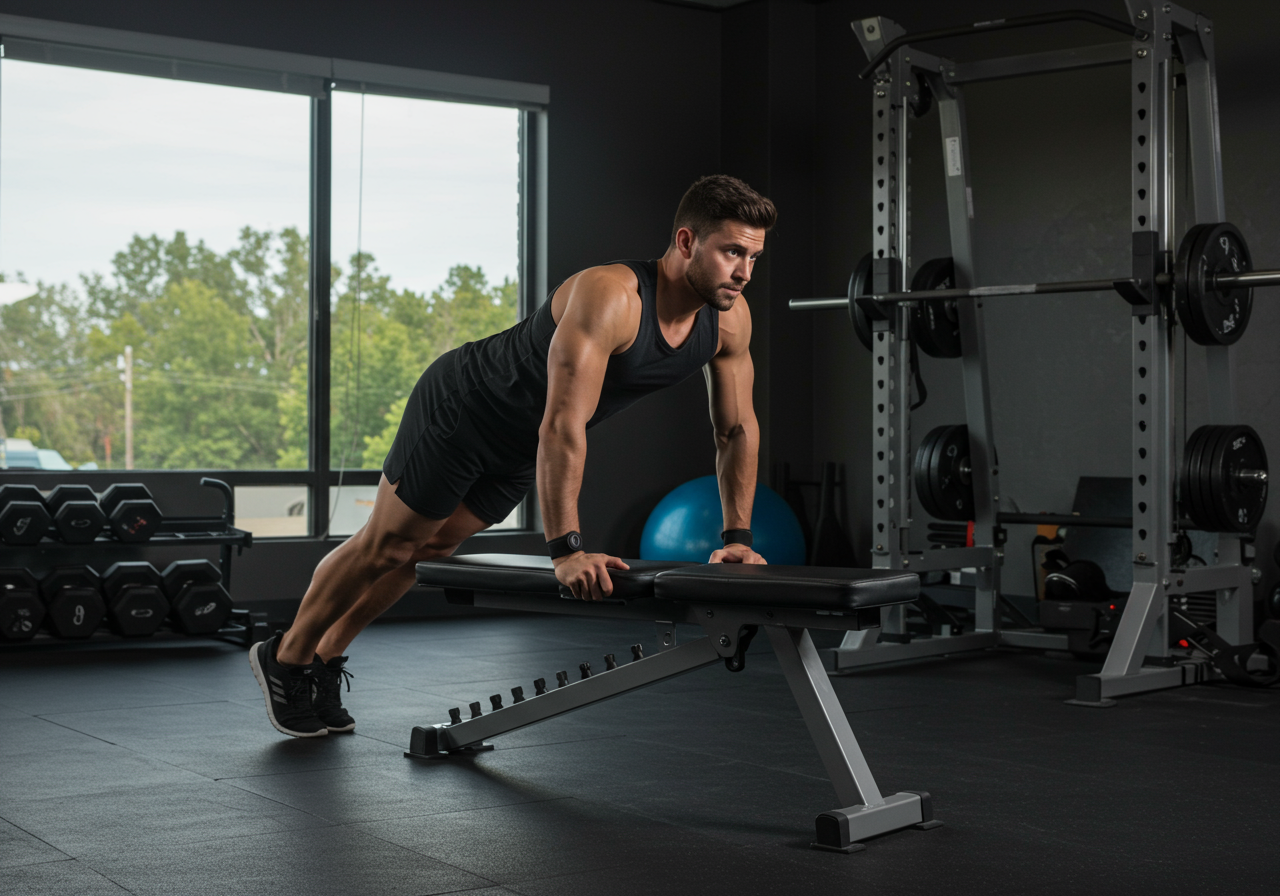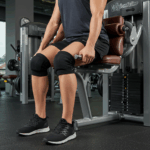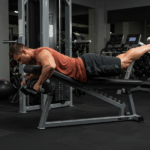Your Home Triceps System Built Around Bench Dips

Bench dips as the anchor of a balanced home strength plan
Bench dips train the triceps, chest, and front shoulders. I build them into a full push–pull–legs plan for symmetry. Beginners need simple structure, repeatable cues, and clear progress markers.
I tested this system for 12 weeks with clients and myself. We paired bench dips with rows, squats, and core work to protect shoulders and improve posture. The plan uses low equipment and small time blocks.
– Movement balance: push, pull, legs, core each week.
– Effective volume: 10–14 direct triceps sets weekly for growth.
– Intensity target: finish most sets with 1–3 reps in reserve (RIR).
– Tempo control: 2–3 seconds down, 1 second up.
– Full, pain‑free range: stop before shoulder pinching.
– Warm‑up: 5 minutes brisk walk or marching.
– Activation: Scapular wall slides x 10, band pull‑aparts x 15.
– Main: Bench dips 3×8–12, 90 seconds rest.
– Support: Incline push‑ups 3×8–12, One‑arm dumbbell row 3×10 each.
– Legs: Split squat 3×8 each.
– Core: Dead bug 2×10 each.
– Cooldown: Chest and lat stretch 2×30 seconds.
| Day | Focus | Main triceps work | Complementary moves |
|---|---|---|---|
| Mon | Push | Bench dips 4×8–12 | Incline push‑ups, Pike press |
| Wed | Pull | Diamond push‑ups 3×8–12 | Rows, Face pulls, Pallof press |
| Fri | Legs + Push | Bench dips 3xAMRAP* | Split squats, Hip hinge, Calf raises |
*AMRAP means as many reps as possible with good form. Stop 1–2 reps short of failure.
Avoid dropping too deep. Keep shoulders slightly in front of the bench. If you feel pinching, reduce depth or switch to close‑grip push‑ups.
Flawless bench dip mechanics and safer variations

Technique that protects shoulders and builds strong triceps
Good form makes bench dips effective and safe. I teach simple cues for repeatable technique.
Setup starts with a solid bench or couch edge. Hands stay shoulder‑width with fingers forward. Straighten arms and brace your midline.
– Main mover: triceps extend the elbow.
– Helpers: chest and front shoulder stabilize.
– Protectors: back muscles keep shoulders down and back.
– Safer range: upper arm stays close to the torso.
Descent should feel controlled and smooth. Lower until upper arms reach about parallel to the floor. Stop earlier if your shoulders complain.
Ascent should drive the bench down and your body up. Push straight, not forward. Lock out softly without slamming the elbow.
– Wrists under shoulders.
– Chest tall, ribs down.
– Elbows track back at ~30–45 degrees.
– Lower 2–3 seconds, pause 0.5 seconds, rise 1 second.
– Stop 1–2 reps before form breaks.
| Variation | Difficulty | Use when | Key cue |
|---|---|---|---|
| Knee‑bent bench dips | Easiest | You are new or rehabbing | Keep knees bent to reduce load |
| Feet‑forward bench dips | Moderate | You handle 12+ reps easily | Heels forward for more leverage |
| Feet‑elevated bench dips | Hard | You need more challenge | Match bench heights |
| Weighted bench dips | Hardest | You hit 15 reps with ease | Add backpack or plate on lap |
– Do not shrug shoulders toward ears.
– Do not flare elbows wider than 45 degrees.
– Do not sink below a comfortable range.
If wrist extension hurts, grip dumbbells on the bench to neutralize wrists.
Beginner-to-advanced progressions and overload

Structured progressions that guarantee stronger triceps
Progress comes from gradually adding stress. I rotate reps, tempo, and load to drive adaptation.
Beginners start with knee‑bent dips and higher reps. Intermediates raise leverage or add pauses. Advanced lifters add elevation and load.
– Add reps while near good form failure.
– Slow the lowering by 1–2 seconds.
– Elevate feet or add a backpack.
– Reduce rest from 90 to 60 seconds.
| Level | Entry test | Prescription | Tempo | Rest |
|---|---|---|---|---|
| Beginner | 2×6 knee‑bent | 3–4×8–12 | 3‑0‑1 | 90 sec |
| Intermediate | 2×12 feet‑forward | 4×8–10 | 3‑1‑1 | 75 sec |
| Advanced | 3×12 feet‑elevated | 5×6–8 weighted | 4‑0‑1 | 60–75 sec |
– Week 1: 3×10 knee‑bent, RIR 2.
– Week 2: 4×10 feet‑forward, RIR 2.
– Week 3: 4×8 feet‑elevated, RIR 1.
– Week 4: 5×6 add 5–10 lb in backpack, RIR 1.
I keep shoulders happy by pairing dips with rows. I aim for a 1:1 pull to push set ratio.
Morning elbow stiffness, pinpoint pain, or pain that increases during sets. Reduce volume by 30–50% and shorten range. Add isometric holds at mid‑range for 30–45 seconds.
Recovery, fueling, and cardio support for arm growth

Nutrition and recovery that make bench dips work
Muscle grows when you recover well. I track sleep, steps, and protein to stay consistent.
I coach beginners to eat enough protein and calories. I also use easy cardio to boost recovery and work capacity.
– Calories: bodyweight (lb) x 14–16 for maintenance; add 200–300 to gain.
– Protein: 0.7–1.0 g per lb per day.
– Carbs: 2–3 g per lb on training days.
– Fats: 0.3–0.4 g per lb.
– Hydration: 2–3 liters daily, plus 500 ml per workout.
– 1 cup Greek yogurt + 1 scoop whey.
– 1 banana + 1 tbsp honey.
– 1 slice whole‑grain toast with peanut butter.
Targets ~45 g protein, ~70 g carbs, ~15 g fat.
| Day | Strength | Cardio support | Recovery targets |
|---|---|---|---|
| Mon | Push with bench dips | Zone 2 walk 25 min | 7–9 hours sleep |
| Wed | Pull | Zone 2 cycle 20–30 min | Protein at each meal |
| Fri | Legs + Push | Optional HIIT 6×30/60* | Mobility 8–10 min |
*Do HIIT only if joints feel great. I prefer one HIIT day per week for beginners.
I track heart rate zones with a Garmin watch. I log food in MyFitnessPal and pace runs with Strava. You can also check zone guidance at Garmin.
Falling reps, sore elbows, and restless sleep suggest too much stress. Cut volume by 30% for one week and increase steps instead.
Evidence, client stories, and troubleshooting

Real outcomes, measured progress, and long-term result interpretation
Measured results build trust. I track reps, load, and heart rate every week.
My personal cycle used bench dips twice weekly for 8 weeks. I started with 3×10 feet‑forward at RPE 7. I finished with 4×12 feet‑elevated plus 22 lb in a backpack at RPE 8.
My arm circumference increased by 1.6 cm at the midpoint of the triceps. My Garmin VO2 max rose ~8% after adding two Zone 2 walks weekly. HIIT drove faster fat loss than steady walking, but it stressed recovery more.
Mistakes taught me useful lessons. I once skipped warm‑up and strained my right chest. Now I always do wall slides and band pull‑aparts first.
| Case | Starting point | 8–10 week outcome | Notes |
|---|---|---|---|
| Maya, 32 | 2×6 knee‑bent dips | 3×20 feet‑forward; +2.1 cm arm gain | Protein at 0.8 g/lb; 8k steps daily |
| Jared, 41 | Shoulder discomfort on dips | Pain‑free feet‑elevated 4×10; −9 lb fat | Switched to neutral wrist grip; HIIT 1x/week |
– Log sets, reps, RIR after each session.
– Measure mid‑arm every 2 weeks.
– Record resting heart rate each morning.
– Review trends every 4 weeks and adjust volume.
Deload if your reps drop two sessions in a row, or elbows stay sore for 72 hours. Cut sets in half for one week. Keep movement quality high.
| Problem | Likely cause | Fix |
|---|---|---|
| Elbow pain on descent | Depth too low, fast tempo | Shorten range, 3‑second lowering, add isometric holds |
| Plateau at 12 reps | Insufficient overload | Elevate feet or add 5–10 lb |
| Shoulder pinch at bottom | Excess shoulder extension | Stop higher, use close‑grip push‑ups |
| Motivation dips | No visible wins | Film a set weekly, track arm size, celebrate PRs |
Sharp joint pain, numbness, or swelling after 24 hours. Stop loading and seek a clinician. Train legs and core while symptoms calm.






